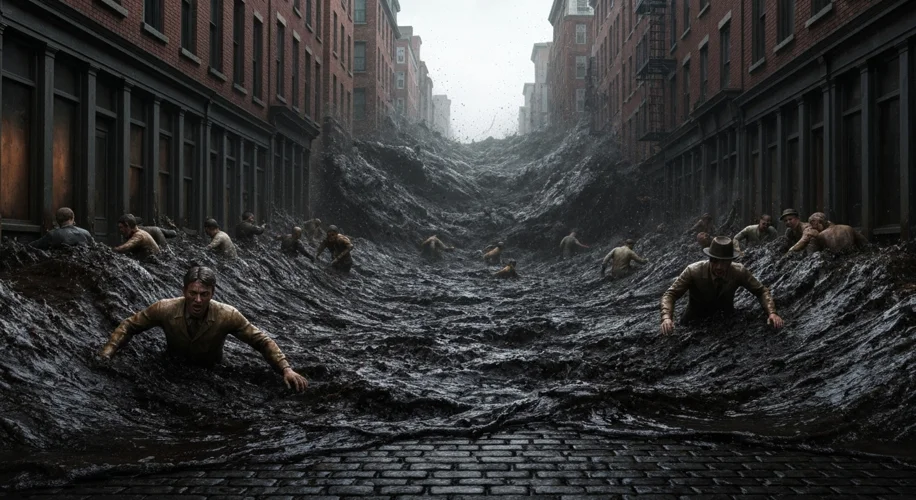The air in Boston on January 15, 1919, was unseasonably warm for a January day. Citizens bustled through the North End, a vibrant immigrant neighborhood, unaware that a slow-moving catastrophe was about to engulf them. The cause? Not a bomb, not a fire, but something far more bizarre and deadly: a colossal wave of molasses.

Under normal circumstances, molasses is a sticky, sweet byproduct of sugar refining. But on this fateful day, a massive storage tank owned by the Purity Distilling Company, located on Commercial Street, burst its seams. This wasn’t just any tank; it was a behemoth, holding an estimated 2.3 million gallons (over 8.7 million liters) of the syrupy liquid. The tank had been hastily constructed and poorly maintained, its metal sides groaning under the immense pressure of the molasses, which had been recently delivered and was being warmed to aid in its transfer. The warming process, however, likely exacerbated the already dangerous internal stress.
Suddenly, with a deafening roar that echoed through the narrow streets, the tank ruptured. A colossal wave, estimated to be up to 25 feet high and moving at an alarming speed of 35 miles per hour, surged through the neighborhood. The sheer force of the molasses was unimaginable. It tore buildings from their foundations, buckled elevated train tracks, and swept away horses, wagons, and unsuspecting pedestrians.
The scene that followed was one of horror and chaos. People were trapped, suffocated, or crushed by the viscous tide. Horses drowned in the sticky goo, their desperate whinnies quickly silenced. The sweet scent of molasses turned into a suffocating, putrid odor as the disaster unfolded. Rescuers, themselves wading through waist-deep goo, struggled to pull survivors from the thick, clinging substance. The dark, sticky mass made every movement a Herculean effort, and many who initially survived the initial surge later succumbed to their injuries or the agonizing process of being extricated.
The aftermath was devastating. The official death toll stood at 21, with an additional 150 people injured. The clean-up operation was as daunting as the disaster itself. Firefighters struggled to wash away the molasses, resorting to saltwater from the harbor. The sticky residue permeated everything – the streets, the buildings, the very air – for weeks, if not months, afterwards. The North End was left coated in a thick, brown layer, a stark and eerie reminder of the day the sweet turned deadly.

This bizarre tragedy, which became known as the Great Molasses Flood, quickly led to one of the first major class-action lawsuits in Massachusetts. The Purity Distilling Company, and its parent company United States Industrial Alcohol (USIA), initially tried to blame anarchists for the explosion, a desperate attempt to deflect responsibility. However, evidence presented during the lengthy legal proceedings painted a clear picture of corporate negligence. Witnesses testified to the tank’s faulty construction, the groaning sounds it made, and the visible leaks that had been ignored.
The court ultimately found USIA responsible, ordering them to pay substantial damages to the victims and their families. This landmark ruling set a precedent for corporate accountability and highlighted the importance of safety regulations in industrial operations. It was a bitter lesson learned, albeit at a terrible cost.
The Great Molasses Flood remains a peculiar and tragic footnote in American history. It serves as a stark reminder that even the most mundane substances can become instruments of destruction when safety and responsibility are neglected. The sweet scent of molasses in Boston’s North End would forever carry an undertone of sorrow, a sticky testament to a disaster that was as unexpected as it was deadly.

